Port-Related Emissions, Environmental Impacts and Their Implication on Green Traffic Policy in Shanghai
Abstract
1. Introduction
2. Materials and Methods
2.1. Study Area and Period
2.2. Source of Basic Machinery Data
2.3. Estimation Method of Emissions from Cargo-Handling Equipment
2.4. Estimation Method of Emissions from External Container Trucks
2.5. Air Quality Modeling
3. Results
3.1. Engine Power and Emission Status of Port-Related Equipment and Fuel Consumption
3.2. Port-Related Emission Inventory
3.2.1. Cargo-Handling Equipment
3.2.2. External Port-Related Container Trucks
3.3. Air Quality Impact
4. Discussions
5. Conclusions
Author Contributions
Funding
Acknowledgments
Conflicts of Interest
Appendix A
| First | Second | Third | Fourth | |
|---|---|---|---|---|
| Grading standard | Machine type | Fuel type | Rated power (kw) | Emission standard |
| Grading | Forklift Vehicles Hoisting machinery Towing tractor Other industrial machinery | Diesel Gasoline LNG LPG Electricity Other fuel type | ≤19 (19,37) [37,56) [56,75) [75,130) [130,560) ≥560 | China 0 China 1 China 2 China 3 China 4 China 5 |
| Emission Standard | Air Pollutant | Emission Factor (g/km) |
|---|---|---|
| China 1 | CO | 0.00 |
| China 2 | CO | 0.00 |
| China 3 | CO | 4.40 |
| China 4 | CO | 2.50 |
| China 5 | CO | 2.50 |
| China 1 | VOCS | 0.00 |
| China 2 | VOCS | 0.00 |
| China 3 | VOCS | 1.16 |
| China 4 | VOCS | 0.72 |
| China 5 | VOCS | 0.72 |
| China 1 | NOX | 0.00 |
| China 2 | NOX | 0.00 |
| China 3 | NOX | 15.88 |
| China 4 | NOX | 13.77 |
| China 5 | NOX | 11.72 |
| China 1 | PM2.5 | 0.00 |
| China 2 | PM2.5 | 0.00 |
| China 3 | PM2.5 | 0.77 |
| China 4 | PM2.5 | 0.42 |
| China 5 | PM2.5 | 0.26 |
| China 1 | PM10 | 0.00 |
| China 2 | PM10 | 0.00 |
| China 3 | PM10 | 0.85 |
| China 4 | PM10 | 0.46 |
| China 5 | PM10 | 0.29 |
| China 1 | CO2 | 0.00 |
| China 2 | CO2 | 0.00 |
| China 3 | CO2 | 894.17 |
| China 4 | CO2 | 894.17 |
| China 5 | CO2 | 894.17 |
References
- Chen, S. The Research on Evaluation of Green Port in Shanghai Port. Master’s Thesis, Nanchang University, Nanchang, China, 2016. [Google Scholar]
- Li, J.B.; Oh, Y.S. A Research on Competition and Cooperation Between Shanghai Port and Ningbo-Zhoushan Port. Asian J. Shipp. 2010, 26, 67–91. [Google Scholar] [CrossRef]
- Mou, N.; Wang, C.; Yang, T.; Zhang, L. Evaluation of Development Potential of Ports in the Yangtze River Delta Using FAHP-Entropy Model. Sustainability 2020, 12, 493. [Google Scholar] [CrossRef]
- Ren, J.; Dong, L.; Sun, L. Competitiveness prioritisation of container ports in Asia under the background of China’s Belt and Road initiative. Transp. Rev. 2018, 38, 436–456. [Google Scholar] [CrossRef]
- Johnson, T.; Rogan, E.; Pope, J. 2005 Green Port Annual Report; Maryland Port Administration: Baltimore, MD, USA, 2005.
- Cannon, C.; Tomley, H. San Pedro Bay Ports Clean Air Action Plan 2017; Port of Los Angeles: San Pedro, CA, USA, 2017. [Google Scholar]
- Bonner, A.; Snedden, P.; Mayson, J.; Haydon, S.; Smith, K.; Osborne, B. Ports of Auckland Annual Report 2017; Ports of Auckland Limited: Auckland, New Zealand, 2017. [Google Scholar]
- Madalin, A.; Alina, M.; Daniela, S.; Ambroziu, D.; Ciprian, H. Annual Report—Port of Constanta 2015; Port of Constanta: Constanta, Romania, 2015. [Google Scholar]
- Gonzalez Aregall, M.; Bergqvist, R.; Monios, J. A global review of the hinterland dimension of green port strategies. Transp. Res. Part D Transp. Environ. 2018, 59, 23–34. [Google Scholar] [CrossRef]
- Yong, L.U.; Hao, H.U. Sydney Port′s Practice in Green Port Development and China′s Inspiration from it. Navig. China 2009, 32, 72–75. [Google Scholar]
- Han, C.H. Air Pollution Reduction Strategies of World Major Ports. Int. Commer. Law Rev. 2010, 48, 27–56. [Google Scholar]
- Qin, C. Discussion on Setting up the Area of International Ship Emission Control Area in China. Energy Conserv. Environ. Prot. Transp. 2018, 14, 25–28. [Google Scholar]
- Li, Y.; Zhang, X.; Lin, K.; Huang, Q. The Analysis of a Simulation of a Port–City Green Cooperative Development, Based on System Dynamics: A Case Study of Shanghai Port, China. Sustainability 2019, 11, 5948. [Google Scholar] [CrossRef]
- Han, C.H. Green Port Strategies for Reducing Air Pollution in Port of Incheon. J. Korea Port Econ. Assoc. 2011, 27, 281–304. [Google Scholar]
- Peng, C.Y.; Lin, C.G.; Jong, T.C. Emissions of particulate and gaseous pollutants within the Keelung harbor region of Taiwan. Environ. Monit. Assess. 2005, 109, 37–56. [Google Scholar] [CrossRef]
- Li, Z.; Feng, C.J.; Ya, D.J. Air Pollution and Control of Cargo Handling Equipments in Ports. In Proceedings of the 2018 International Conference on Green Energy and Environment Engineering, Kitahiroshima, Japan, 27–29 August 2018; Wang, Y., Ed.; E D P Sciences: Les Ulis, France, 2019; Volume 93. [Google Scholar]
- Isakov, V.; Barzyk, T.; Arunachalam, S.; Snyder, M.; Venkatram, A. A Community-Scale Modeling System to Assess Port-Related Air Quality Impacts; Springer Int Publishing Ag: Cham, Switzerland, 2016; pp. 385–390. [Google Scholar]
- Arunachalam, S.; Brantley, H.; Barzyk, T.M.; Hagler, G.; Isakov, V.; Kimbrough, E.S.; Naess, B.; Rice, N.; Snyder, M.G.; Talgo, K.; et al. Assessment of port-related air quality impacts: Geographic analysis of population. Int. J. Environ. Pollut. 2015, 58, 231–250. [Google Scholar] [CrossRef]
- International, I. Current Methodologies in Preparing Mobile Source Port-Related Emission Inventories. In Final Report for US Environmental Protection Agency; US Environmental Protection Agency: Washington, DC, USA, 2009. [Google Scholar]
- Li, D.; Wu, Y.; Zhou, Y.; Du, X.; Fu, L. Fuel Consumption and Emission Inventory of Typical Construction Equipments in China. Chin. J. Environ. Sci. 2012, 33, 518–524. [Google Scholar]
- Samaras, Z.; Zierock, K.H. OFF-ROAD VEHICLES—A COMPARISON OF EMISSIONS WITH THOSE FROM ROAD TRANSPORT. Sci. Total Environ. 1995, 169, 249–255. [Google Scholar] [CrossRef]
- Agrawal, A.; Aldrete, G.; Anderson, B.; Muller, R.; Ray, J. Inventory of Air Emissions for Calendar Year 2013; Starcrest: Longbeach, CA, USA, 2014. [Google Scholar]
- Fu, M.; Ge, Y.; Tan, J.; Zeng, T.; Liang, B. Characteristics of typical non-road machinery emissions in China by using portable emission measurement system. Sci. Total Environ. 2012, 437, 255–261. [Google Scholar] [CrossRef]
- Zhang, Y.; Peng, Y.-Q.; Wang, W.; Gu, J.; Wu, X.-J.; Feng, X.-J. Air emission inventory of container ports’ cargo handling equipment with activity-based “bottom-up” method. Adv. Mech. Eng. 2017, 9, 1–9. [Google Scholar] [CrossRef]
- Shon, Z.-H. Emissions of Ozone Precursors from a Biogenic Source and Port-related Sources in the Largest Port City of Busan, Korea. Asian J. Atmos. Environ. 2015, 9, 39–47. [Google Scholar] [CrossRef]
- Kean, A.J.; Sawyer, R.F.; Harley, R.A. A fuel-based assessment of off-road diesel engine emissions. J. Air Waste Manag. Assoc. 2000, 50, 1929–1939. [Google Scholar] [CrossRef]
- Tan, H.; Liu, J.; Shen, Y.; Fang, Y. Emission Inventory of Air Pollutants from Cargo Handling Equipments. Environ. Sci. Manag. 2013, 38, 82–87. [Google Scholar]
- Fan, X.; Xia, Z.; Li, C. An Improved Method for Building an Emission Inventory for Cargo Handling Equipment and Its Application. Res. Environ. Sci. 2017, 30, 628–635. [Google Scholar]
- Dragović, B.; Tzannatos, E.; Tselentis, V.; Meštrović, R.; Škurić, M. Ship emissions and their externalities in cruise ports. Transp. Res. Part D Transp. Environ. 2018, 61, 289–300. [Google Scholar] [CrossRef]
- Huang, L.; Wen, Y.; Geng, X.; Zhou, C.; Xiao, C. Integrating multi-source maritime information to estimate ship exhaust emissions under wind, wave and current conditions. Transp. Res. Part D Transp. Environ. 2018, 59, 148–159. [Google Scholar] [CrossRef]
- López-Aparicio, S.; Tønnesen, D.; Thanh, T.N.; Neilson, H. Shipping emissions in a Nordic port: Assessment of mitigation strategies. Transp. Res. Part D Transp. Environ. 2017, 53, 205–216. [Google Scholar] [CrossRef]
- Smailys, V.; Rapalis, P.; Strazdauskiene, R.; Esmantaite, V.; Kaunas University Technology Press. Air Pollution by NOx from Ships Passing Klaipeda Port Channel. In Transport Means 2013; Kaunas University Technology Press: Kaunas, Lithuania, 2013; pp. 97–100. [Google Scholar]
- Bailey, D.; Solomon, G. Pollution prevention at ports: Clearing the air. Environ. Impact Assess. Rev. 2004, 24, 749–774. [Google Scholar] [CrossRef]
- Feng, J.; Zhang, Y.; Li, S.; Mao, J.; Patton, A.P.; Zhou, Y.; Ma, W.; Liu, C.; Kan, H.; Huang, C.; et al. The influence of spatiality on shipping emissions, air quality and potential human exposure in the Yangtze River Delta/Shanghai, China. Atmos. Chem. Phys. 2019, 19, 6167–6183. [Google Scholar] [CrossRef]
- Lu, J.; Huang, C.; Hu, Q.-Y.; Yang, Q.; Jing, B.L.; Xia, Y.; Lu, B.; Tang, W.; Lou, S.R.; Tao, S.K.; et al. Air Pollutant Emission Inventory of Non-road Machineries in Typical Cities in Eastern China. Environ. Sci. 2017, 38, 2738–2746. [Google Scholar]
- Xie, Y.; Ji, W. The Study of Factors Affecting the Limits in the Standard of Non-road Diesel Engine Fuel Consumption Limits. Diesel Engine 2010, 32, 1–4. [Google Scholar]
- Xu, J.; Feng, X.; Jiang, L. Research of Air Pollutants from Cargo Handling Equipments. J. East China Jiaotong Univ. 2014, 31, 12–17. [Google Scholar]
- Fan, Q.; Zhang, Y.; Ma, W.; Ma, H.; Feng, J.; Yu, Q.; Yang, X.; Ng, S.K.; Fu, Q.; Chen, L. Spatial and Seasonal Dynamics of Ship Emissions over the Yangtze River Delta and East China Sea and Their Potential Environmental Influence. Environ. Sci. Technol. 2016, 50, 1322–1329. [Google Scholar] [CrossRef]
- Jalkanen, J.P.; Brink, A.; Kalli, J.; Pettersson, H.; Kukkonen, J.; Stipa, T. A modelling system for the exhaust emissions of marine traffic and its application in the Baltic Sea area. Atmos. Chem. Phys. 2009, 9, 9209–9223. [Google Scholar] [CrossRef]
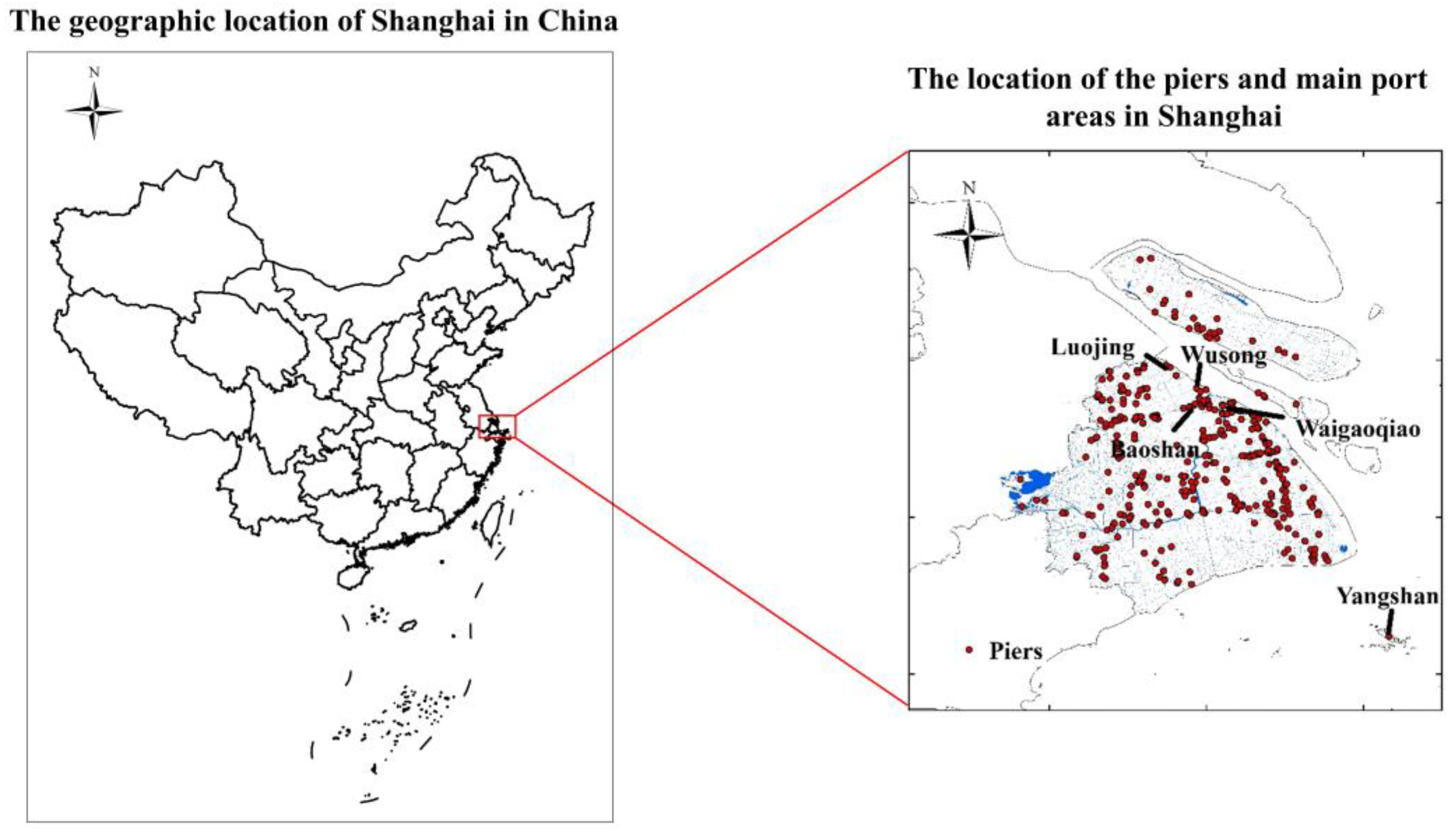
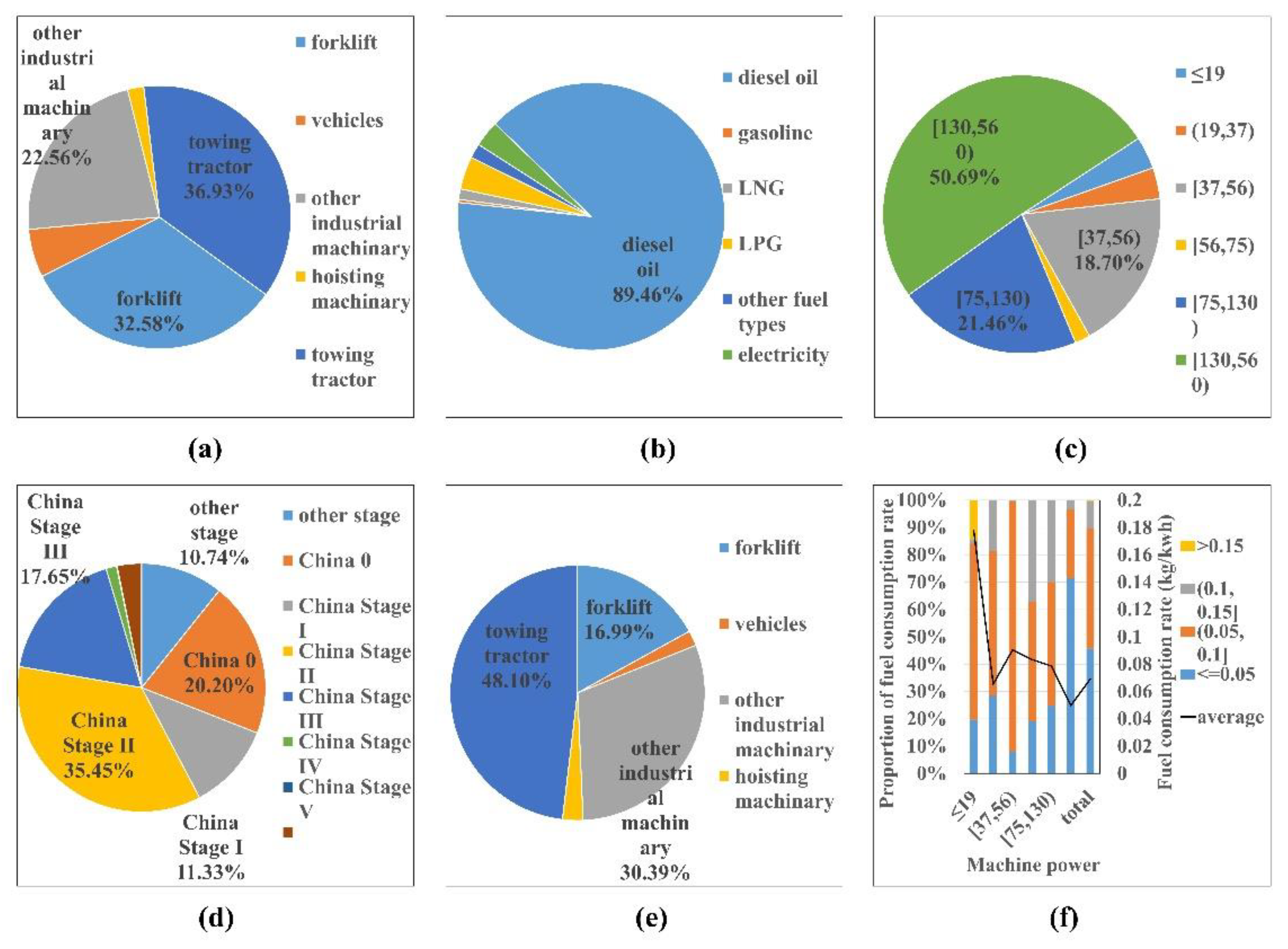

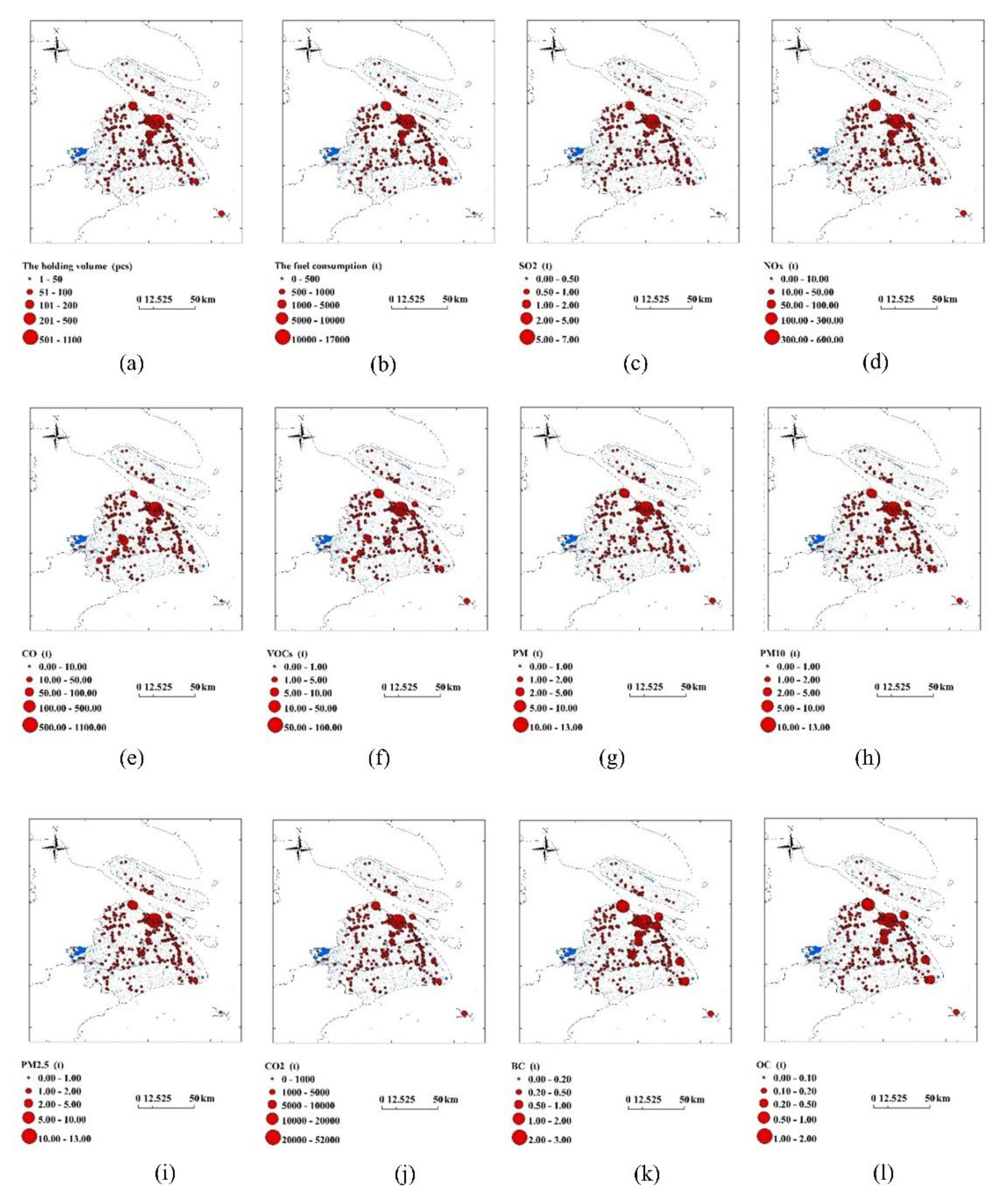

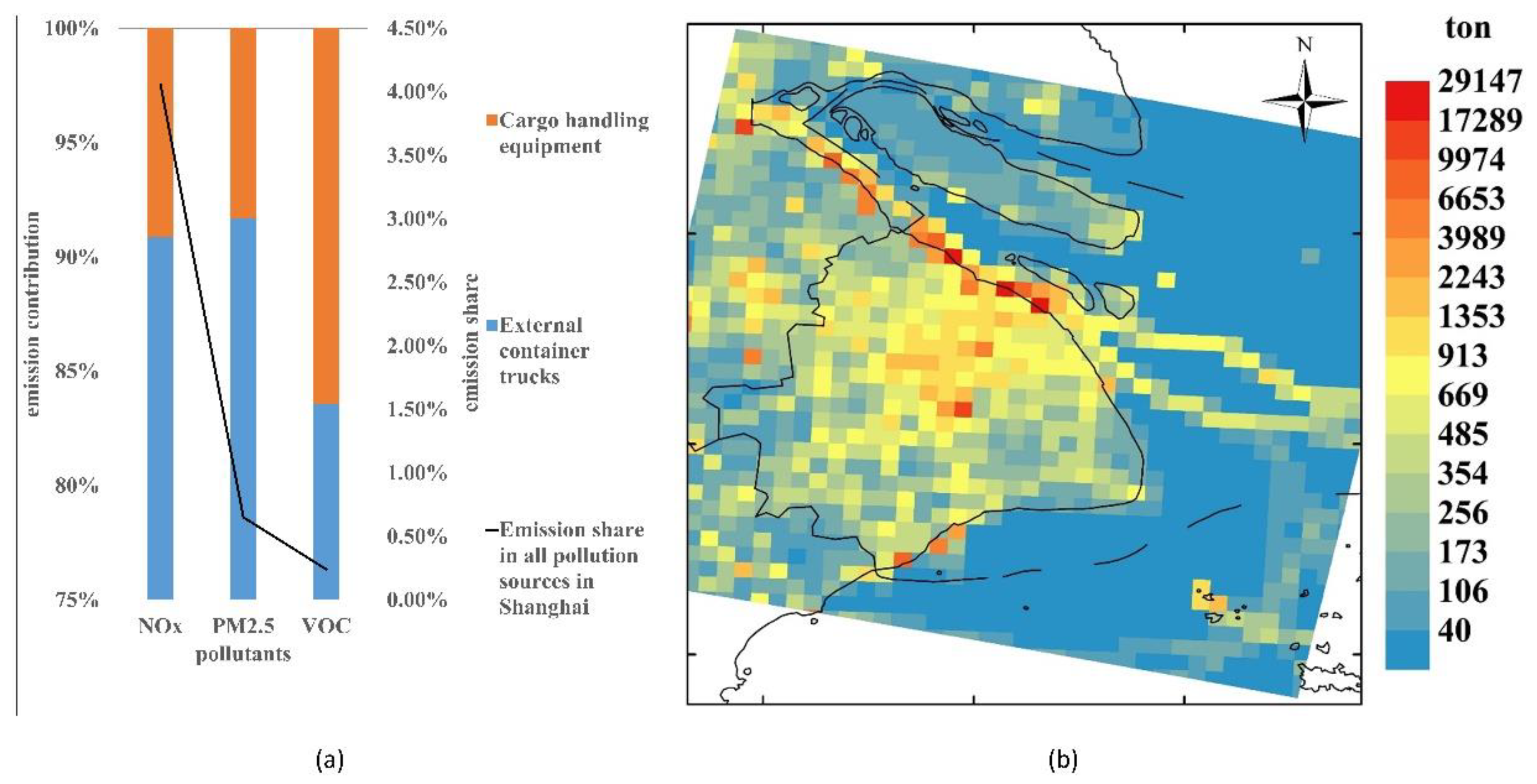
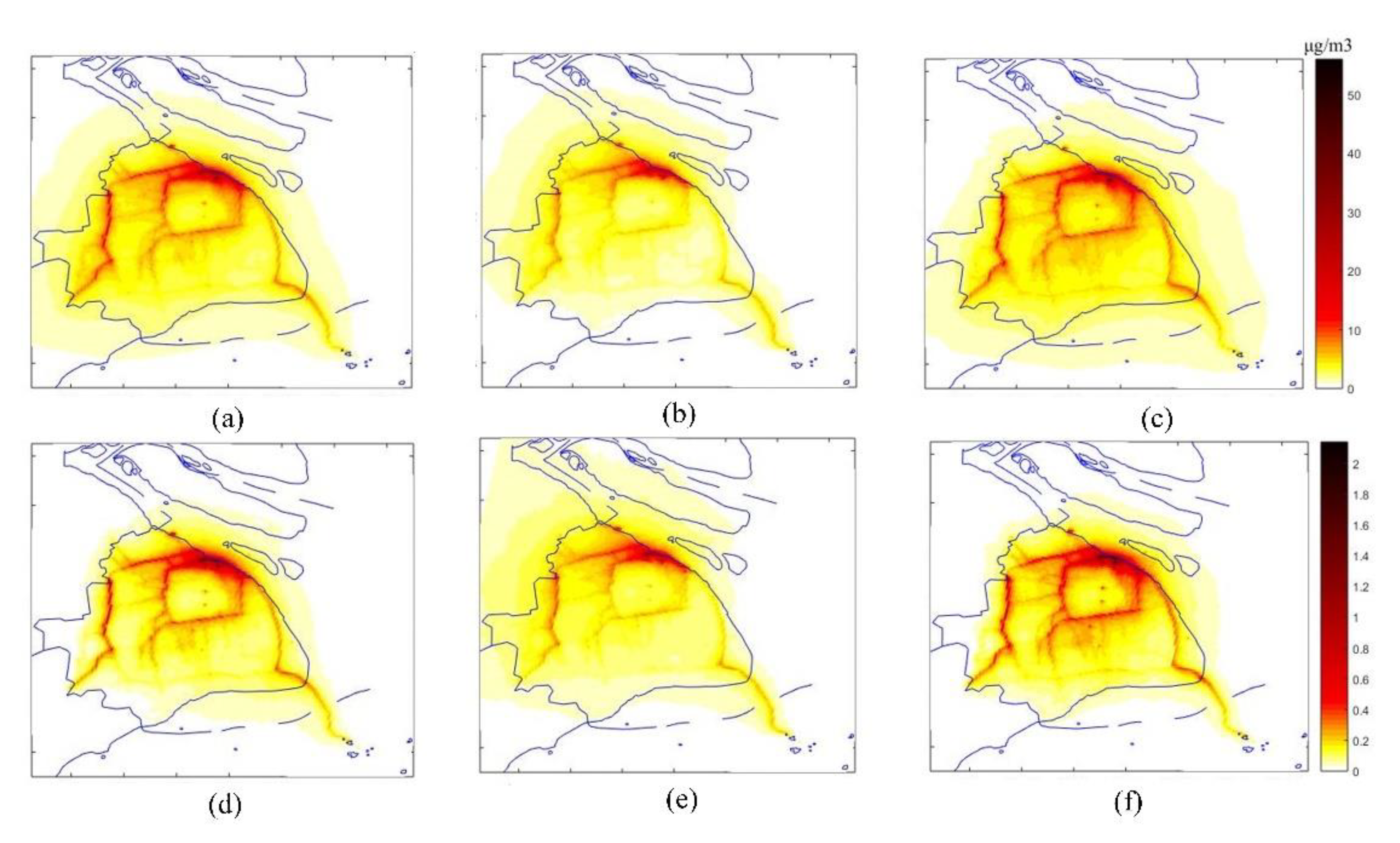

| In-Port Sources of Pollution | Forklift | Vehicles | Other Industrial Machinery | Hoisting Machinery | Towing Tractor | Total of Machineries | External Container Trucks | |
|---|---|---|---|---|---|---|---|---|
| Holding volume | 1274.00 | 232.00 | 882.00 | 78.00 | 1444.00 | 3910.00 | — | |
| Fuel consumption/t | 7743.54 | 876.67 | 13,848.27 | 1185.81 | 21,921.23 | 45,575.51 | — | |
| Emission/t | SO2 | 4.20 | 0.47 | 7.28 | 0.24 | 9.70 | 21.88 | — |
| NOX | 372.24 | 48.49 | 621.47 | 40.59 | 728.42 | 1811.22 | 18,002.9 | |
| CO | 122.74 | 32.90 | 286.41 | 179.75 | 1119.91 | 1741.72 | 5308.05 | |
| VOCS | 31.78 | 9.33 | 56.43 | 13.89 | 111.32 | 222.76 | 1134.57 | |
| PM | 17.53 | 1.89 | 23.66 | 0.70 | 17.74 | 61.52 | — | |
| PM10 | 17.53 | 1.80 | 23.66 | 0.70 | 17.74 | 61.43 | 711.12 | |
| PM2.5 | 16.66 | 1.74 | 22.48 | 0.67 | 16.87 | 58.41 | 640.59 | |
| CO2 | 24,459 | 2766 | 43,558 | 3441 | 67,581 | 141,805 | — | |
| BC | 9.49 | 0.39 | 12.81 | 0.38 | 3.73 | 26.80 | — | |
| OC | 3.00 | 0.28 | 4.05 | 0.12 | 2.63 | 10.07 | — | |
© 2020 by the authors. Licensee MDPI, Basel, Switzerland. This article is an open access article distributed under the terms and conditions of the Creative Commons Attribution (CC BY) license (http://creativecommons.org/licenses/by/4.0/).
Share and Cite
Zhou, Y.; Zhang, Y.; Ma, D.; Lu, J.; Luo, W.; Fu, Y.; Li, S.; Feng, J.; Huang, C.; Ge, W.; et al. Port-Related Emissions, Environmental Impacts and Their Implication on Green Traffic Policy in Shanghai. Sustainability 2020, 12, 4162. https://doi.org/10.3390/su12104162
Zhou Y, Zhang Y, Ma D, Lu J, Luo W, Fu Y, Li S, Feng J, Huang C, Ge W, et al. Port-Related Emissions, Environmental Impacts and Their Implication on Green Traffic Policy in Shanghai. Sustainability. 2020; 12(10):4162. https://doi.org/10.3390/su12104162
Chicago/Turabian StyleZhou, Yuyan, Yan Zhang, Dong Ma, Jun Lu, Wenbin Luo, Yu Fu, Shanshan Li, Junlan Feng, Cheng Huang, Wangqi Ge, and et al. 2020. "Port-Related Emissions, Environmental Impacts and Their Implication on Green Traffic Policy in Shanghai" Sustainability 12, no. 10: 4162. https://doi.org/10.3390/su12104162
APA StyleZhou, Y., Zhang, Y., Ma, D., Lu, J., Luo, W., Fu, Y., Li, S., Feng, J., Huang, C., Ge, W., & Zhu, H. (2020). Port-Related Emissions, Environmental Impacts and Their Implication on Green Traffic Policy in Shanghai. Sustainability, 12(10), 4162. https://doi.org/10.3390/su12104162





